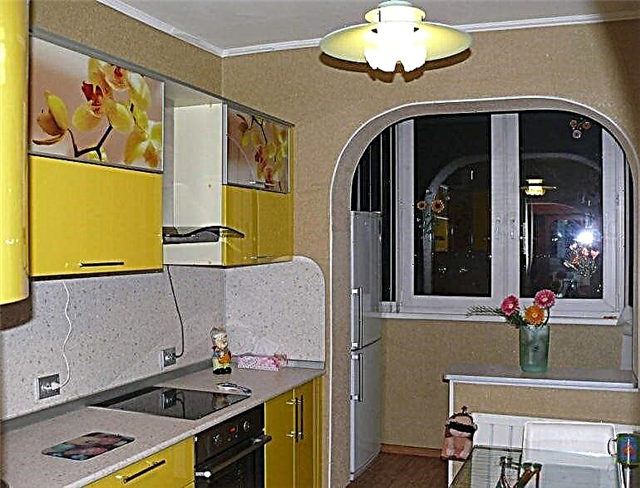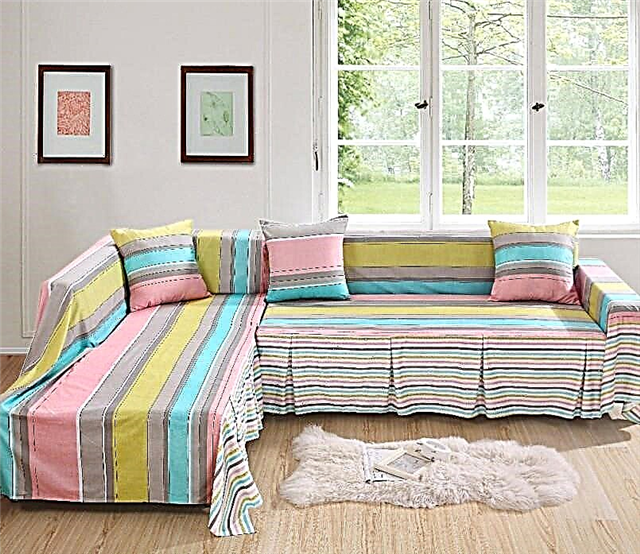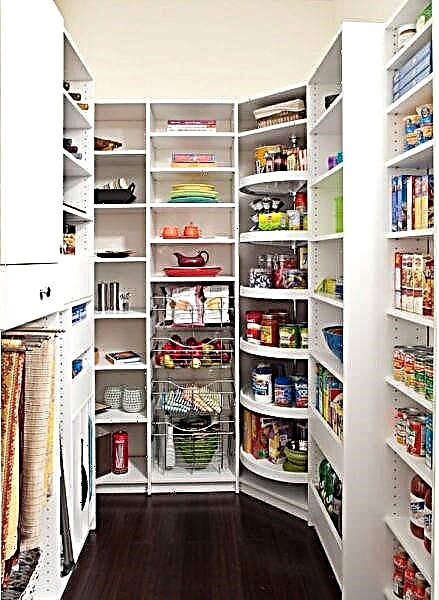
Brown is not as boring as it might seem at first glance, although it is associated with a school uniform. This is a universal color scheme with a rich palette of warm and cold shades, which is especially popular among balanced and practical personalities. It is equally well used in makeup, clothing and interior design. The brown color in the interior is the most natural, since it imitates the natural shade of wood, which has long been the main decoration tool.
Materials and features of the combination of colors
Despite the fact that modern design delights have pushed brown to the background, it still personifies solidity, stability, nobility, and also gives a feeling of warm embrace.

Mosaic as an original alternative to the usual ceramic tiles can diversify the interior of any room.
Choosing a mosaic composition of noble chocolate shades, you can easily add a twist to the most rigorous design.


Despite the numerous advantages, the mosaic has only recently begun to gain popularity as a finishing material, since there were not many who wanted to work with elements (chips) of 5x5 cm and even 2x2 cm in size. Not so long ago mosaic elements were created on strong mesh sheets. Now, finishing work is minimized - you need to prepare the surface, and then just glue the grid with the chips.


For such "mesh" products, different materials are used:
- Glass. Such options are resistant to aggressive detergents and temperature extremes, affordable, and also have various options.
- Ceramics It has great potential in simulating textures, for example, wood, while possessing significant moisture resistance.
- Tree little in demand, because the natural texture is prone to swelling and cracking, although it gives the room unconditional comfort.
- A rock - Strong and durable material with excellent anti-slip properties, so it is actively used to cover the floor. The main disadvantage is the high cost.
It is important to choose the right combination of brown mosaic, then a special atmosphere will appear in your interior:
- light shades make you feel light
- darker - relaxation,
- reddish brown will add energy
- and in rooms without windows and sunshine, glare of light brown and yellow tones is needed,
- in any room, a combination of white and brown will be appropriate.
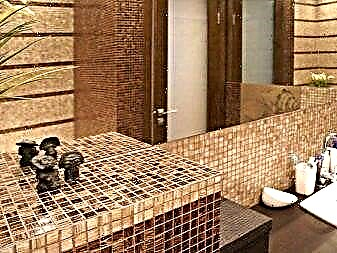


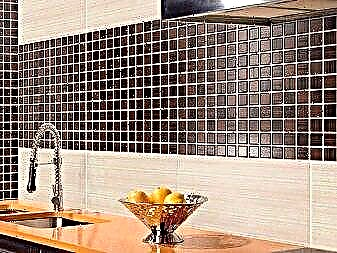
The monochrome beige-brown interior is a harmonious and beautiful combination that looks warmer and more comfortable than white-brown, so it fits perfectly into the design of a small living room or bedroom.
The energetic and positive tandem of tan is ideal for country and retro styles, although it looks organically in any interior.
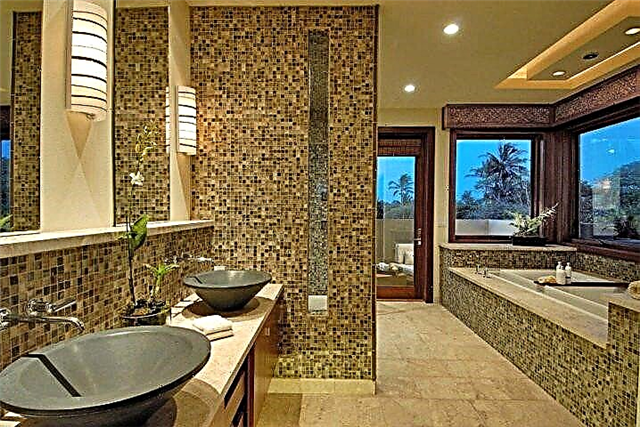
Traditionally oriental is a brown-orange combination. It can often be found in the design of bedrooms and boudoirs, however, both the bathroom and the kitchen look excellent.
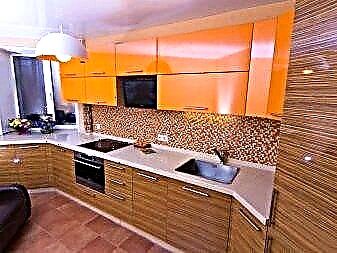
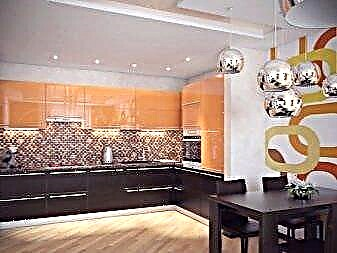
Beautiful options in different interiors
The kitchen is the place where all family members gather most often. To give an atmosphere of coziness and tranquility (as well as a spectacular accent), you can safely use the mosaic tiles of the entire brown range. It will be in harmony with the white, black, green furniture of the kitchen, ideal for decorating an apron, and in large rooms it will also decorate the countertop.
The bathtub, decorated in warm luxury of brown shades, looks very impressive. A combination of brown and gold is very popular - it looks aristocratic, but unusual.


The golden mosaic in itself looks exceptional. It is not necessary to lay out intricate patterns from it.

Mixes of mosaics of different sizes with a combination of different shades of brown that look fresh are very popular: there are models with gold, sparkles, mother of pearl, imitation of amber and natural stone.

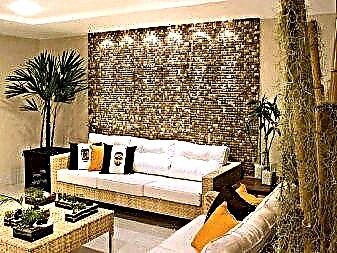
Mosaic is an excellent interior solution. Its aesthetics and practicality will find their application in any corner of your home. By choosing a mosaic of noble gamut of brown shades, you will demonstrate the elegance and impeccability of taste.
An overview of the mosaic in the interior, see the next video.
Fashion trend number 1. HEXAGON
Hexagonal tiles - a traditional element of decor, similar motifs are often found in historical interiors of the XVIII-XIX centuries, in the mansions of European nobility. Today, hexagon tiles are again at the peak of fashion, its main differences are its large size and bright colors.
1. The wall in the cafe is decorated with a panel of ceramic tiles in a hexagonal shape. Large modules fold into multi-colored “shamrocks”. Wall tiles from the Xgone collection, Mirage, www.mirage.it
2. Hexagonal floor tiles with asymmetric patterns from the Contemporary Cement collection, designed by Paola Navone for Bisazza, www.bisazza.it
3. The spacious living room has a respectable appearance thanks to the glossy "marble" floor. Large marble tiles in the shape of elongated hexagons from the Evoque collection, Fap, www.fapceramice.com
4. Hexagon tiles made of glazed porcelain stoneware have a distinctly vintage, aged look. It differs from its historical predecessors in a larger size. Emotive Trace Collection, ImolaCeramica, www.imolaceramica.com
5. Wall tiles from the Xgone collection, Mirage, www.mirage.it
6. Elegant flooring serves as a decorative accent in the interior of the city cafe. Hexagonal tiles are advantageously combined with rectangular modules that simulate a wooden floor. Floor tiles from the Rewind collection, Ragno, www.ragno.it
Fashion trend number 2. SIMULATION OF A TREE
Tile “under the tree” is the current trend of the season. Ceramics cannot be distinguished from wooden coatings either by sight or by touch. But unlike wood, tile is not afraid of water. Ceramic coatings are extremely resistant to mechanical and organic stress. These qualities make the tile an indispensable material for the decoration of both public spaces and private interiors with high traffic.
New technologies allow you to create a ceramic surface that is pleasant to the touch, with a velvety “soft” texture, the sensation of touching which is comparable to touching a fabric or wood.
1. Ceramic tiles from the Scrapwood collection are reminiscent of “coarse” boards from different types of wood, a combination of contrasting colors gives an extraordinary look to the kitchen. Impronta ceramica, www.impronta.it
2. Wall tiles from the Savanna collection, creates the effect of a typeset panel-marquetry. Cerdomus, www.cerdomus.com
3. Vintage motifs are very popular in all areas of design. Ceramic tile from the Club collection is no exception, it looks like wood that has been tested by winds, rains and the scorching sun, Cerdomus, www.cerdomus.com
4. Floor tiles from the Type 32 collection look like a herringbone parquet made of precious wood. Ceramic tile, LeaCeramiche, www.ceramichelea.it
5. Three-dimensional wall tiles from the Bord collection imitate masonry made of wood blocks, AtlasConcorde, www.atlasconcorde.it, www.atlasconcorderussia.ru
6. Floor tiles from the Kerlite Forest collection, imitating parquet. Such a coating is indistinguishable from a natural wood floor not only in appearance but also by touch, Cottod’Este, www.cottodeste.it
7. Floor tiles from the Urban Wood collection “mask” under the cover of aged boards, CeramicaFioranese, www.fioranese.it
8. Floor tiles from the Woodplace collection create the effect of a combined floor of stone and wood, Ragno, www.ragno.it
Fashion trend number 3. Cement Tile
Patterned cement tile is known since ancient times. Recently, this traditional decoration has received rebirth and incredible popularity. Cement tiles have a pleasant to the touch, slightly rough surface, making it impossible to slip on it. The thickness of the patterned layer is on average 0.5 cm, so the pattern is very durable and does not wear out over time. Cement tile is used both in private and in public areas with high traffic. Samples with traditional ornaments bring ethnic chic to the interior, and modern motifs bohemian spirit.
1. Cement tile with a traditional pattern from the Cementine 20 collection, CeramicaFioranese, www.fioranese.it
2, 3. A new look at the possibilities of cement tiles is presented in the Contemporary Cement collection, designed by Paola Navone (2) and Jaime Aion (3) for Bisazza, www.bisazza.com
4. Cement tiles from the Terra collection are decorated with patterns in monochrome colors. Factory Fap, www.fapceramice.com
5. Tiles with geometric patterns from the collection One, Caesar, www.caesar.it
6. Tiles from the collection of Cementine Black & White, Ceramica fioranese, www.fioranese.it
Fashion trend number 4. LARGE FORMAT
New technologies allow you to create superthin ceramic plates with a thickness of only 2-3mm. The thin coating has a much lighter weight, so the size of the modules can be increased. Such plates with a width of 1-1.5 meters can reach 3 meters (!) In length. Thanks to this, new tiles can be used to clad walls, door and furniture structures.
1. Large ceramic modules measuring 60 x 120 cm adorn the floor in the living room of a country house. Cornerstone Collection, Ergon, www.ergontile.it
2, 3. Large format plates with stone effect. The maximum size of the ceramic sheet is 150 x 300 cm, the Maximum collection (2) and the Precious Stones collection (3), Fiandre, www.granitifiandre.com
4. The floor and the wall with a fireplace niche are finished with large porcelain stoneware modules, Portland 325 collections, www.abk.it
5. Large tile imitating stone, from the Anima collection, Caesar, www.caesar.it
6. Large plates with the effect of "rust" from the collection of Kerlite Metal, Cottod’Este, www.cottodeste.it
7. The floor and walls in the living room are decorated with large sheets of porcelain from the Stone Plan collection, ImprontaCeramica, www.impronta.it
Fashion trend number 5. OPTICAL ILLUSIONS
The ornament in the form of a repeatedly repeated "volumetric" cube was found in the palaces of ancient Rome. Colored faces create the illusion of volume, it seems that the image extends beyond the plane. In the twentieth century, this motif was often used in his works by the master of graphic illusions, the Dutch artist Maurice Escher.
1. Wall tiles from the collection of Visual Design, Supergres, www.supergres.it
2. Floor tiles from the Firenze collection, Fap, www.fapceramice.com
3. Tiles from the FS by Peronda collection, Peronda, www.peronda.com
4. Wall and floor tiles with marble effect from the Marvel Pro collection, Atlas Concorde, www.atlasconcorde.it, www.atlasconcorderussia.ru
5. Cement tile from the Contemporary Cement collection, designed by Carlo Dal Bianco for Bisazza, www.bisazza.com
Fashion trend number 6. WATERCOLOR
Delicate watercolor stains on the tiles give a romantic sound to the entire interior. Subtle color shades create the effect of lightness and airiness.
1. Transparent mother-of-pearl influences adorn the tiles from the Visual Design collection, Supergres, www.supergres.com
2. Floor tiles from the collection of Urban Wood, CeramicaFioranese, www.fioranese.it
3.4. Tile from Paper 41 collection from a young Italian company 41zero42, www.41zero42.com
5,6. Picturesque watercolor stains decorate tiles from two collections of Arty and Ewall from the company at once AtlasConcorde, www.atlasconcorde.it, www.atlasconcorderussia.ru
Hirst Shkulev Publishing
Moscow, st. Shabolovka, house 31b, 6th entrance (entrance from Horse Lane)
Features and types
Mosaic as a finishing material began to gain popularity only over the past few years, although it has a large number of advantages. If before, not every master would have taken up work with elements of 5x5 or 2x2 cm, now there are excellent block grids. Elements of the same size with absolutely equal gaps are already pasted onto thin opaque material. Now for work it is enough to prepare the surface, make it absolutely flat and gently glue this mesh.


Brown mosaic made of different materials. The most popular are several species.
- Glass. This material does not react with detergents; it is resistant to a large temperature amplitude. It has a low cost, and is also presented in a large number of options.
- Ceramics. Typically, ceramic elements are created to imitate other materials. The main advantage is moisture resistance.


- Tree. The low demand for wooden elements is explained by the fact that they easily crack and swell. However, when used in the interior, such a mosaic will give the room coziness.
- A rock. This is an expensive material that is durable and durable. Often it is used for laying on the floor, because the main advantage of stone parts is its high anti-slip property.
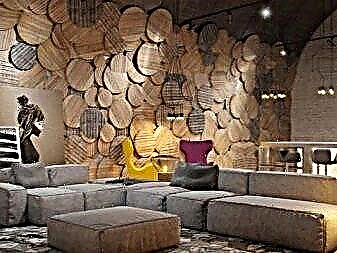

Choice of color and shades
Modern designers rarely pay attention to brown color, putting it into the background. Although this color is perfect for calm, respectable people. It brings a feeling of nobility into the room and gives a feeling of close and warm hugs.
Mosaic is able to diversify any interior. It has long been an excellent alternative to ceramic tiles. A mosaic of chocolate shades is a pleasant highlight in any interior.


It’s important to choose the right shades of brown. It is worth paying attention to the following features:
- light colors give the room lightness,
- dark tones promote relaxation
- more reddish shades add energy,
- Light colors combined with brown and yellow are perfect in rooms without windows where artificial lighting is used.
White is ideally combined with brown, so this tandem can appear in any interior. A great option is a combination of brown and orange. This combination is most often found in the design of bedrooms in oriental style. Beige and brown tiles are good for decorating small rooms.
Beige mosaic is often used to decorate the kitchen. Usually mosaic is used to finish the work area. Beige goes well with any wooden objects, and also looks good against a white kitchen. A beige mosaic with gold elements can be used in kitchens with a large number of black objects - this will create a wonderful contrast.
Brown mosaic is an excellent choice, because it perfectly combines with various colors, and laying a modern mosaic is a simple action.
In the next video, you will find working tricks when laying mosaics.
Brown mosaic - luxury and style in one “bottle”!
To emphasize the status of the room, to give a special chic to the decoration and to balance the colors in the decoration of the house will brown mosaic. Classic shades are in demand always and everywhere, without losing their relevance during the facing works. Therefore, when decorating the bathroom, kitchen, hallway with mosaic tiles in beige and brown, you can be sure that the finishing solution will be “in trend”. Such a color symbolizes the quality factor, harmony, naturalness, constancy, and the aura of the room will be filled with pleasant comfort and act soothingly.
Anyone who prefers brown or yellow mosaic, emphasize their connection with nature. A rich natural color that reflects the warmth of stones, soil, trees, is great for relaxation and pacification. The bathroom will become more comfortable and harmonious if you fill it with the “right” accessories.For example, containers for liquid soap, a curtain for a shower, laundry baskets and even towels can be selected in resonating shades of beige or white. To add more charm, you can buy with brown mosaic and accessories in golden or silver tones, always with a glossy, shiny surface.
Features of color combinations: brown mosaic in the interior
The dark lining is able to make the room visually smaller and give oppression, which can lead to irritability, fatigue. Therefore apply brown or red mosaic should be used with caution, diluting the main tone with lighter impregnations. As an addition, you can use all the accompanying colors that are close to the brown range:
Today, a combination of several shades of the same color laid out in horizontal or vertical rows is relevant. It will not be superfluous to take care of good, high-quality lighting, as well as hang a large mirror and order a stretch ceiling with a glossy effect. Such simple tricks will make a brown mosaic a “star” of decoration! Having visited the catalog of the Mozinka online store, each customer will be able to choose a color and artistic solution to their liking. We have a huge selection and a very attractive price for brown mosaic from China, Turkey, Spain and Italy!
What is a mosaic way of facing
This method has long been known as an art form. For the first time it was used to decorate vases and caskets. Later - chairs and other interior items. And then this method moved to the walls and floors. He was a luxury item, pointing to wealthy people, so he was highly appreciated. It was quite rare in the interior due to the high cost and painstaking work. Previously only houses of nobles and churches were laid out in this way.

The most common type of mosaic is ceramic, made of quartz sand, clay and other additives, on which the durability and wear resistance of the coating depend.
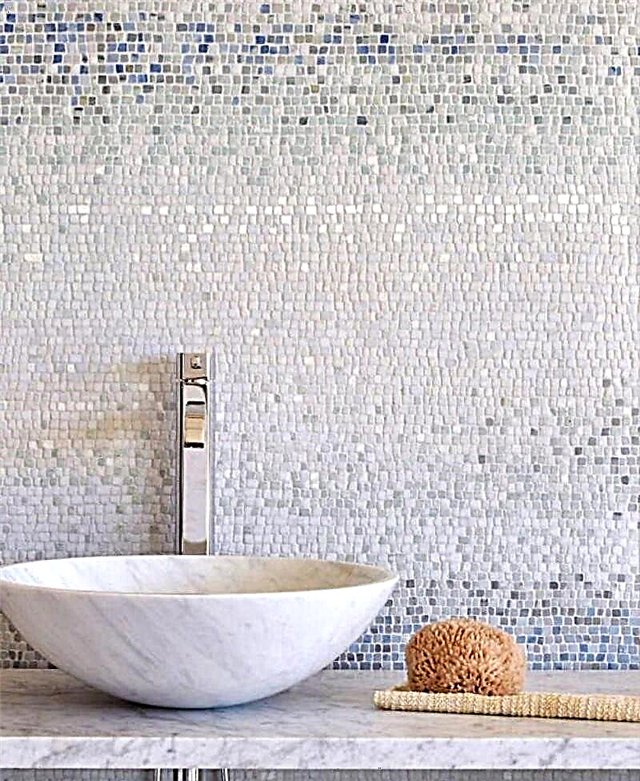
Glass mosaic is not afraid of temperature changes and can be used both indoors and outdoors

Mosaic made of natural stone has a non-slip surface, therefore it is recommended for facing steps and floors
In ancient times, the basis for this art was pieces of fine glass, which were laid out individually in a certain order, making up a pattern or drawing. It was a very hard and painstaking work that took a long time. Basically, the pieces of the picture were made of clay or marble, so the picture had a matte or slightly glossy surface.
In the modern world, this method of facing is greatly simplified. It no longer takes so much time, and it takes less work to do. You can meet mosaic elements not only in a luxurious mansion, but also in an ordinary apartment.
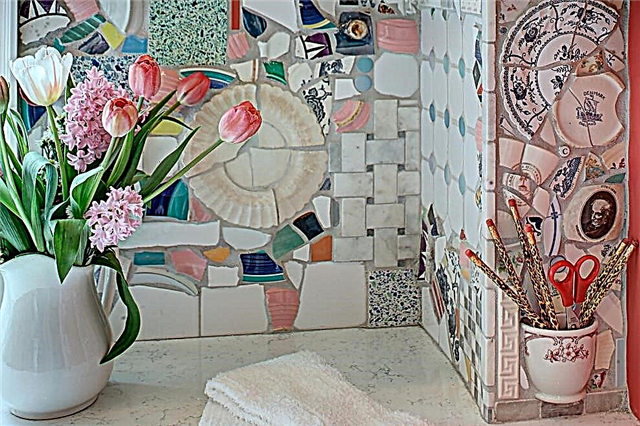
Unusual decor from fragments of old dishes combined with shop-mosaic tiles

A delightful mirror with mosaic trim

A chic countertop laid out by hand from pieces of colored mosaics of various shapes
Now the basis for such cladding is made of artificial materials like ceramics. There are also traditional species made from natural materials such as marble. There is also a view based on glass or porcelain stoneware. The cost of natural materials will be much higher, so to some extent this method has remained expensive. But with the replacement for artificial raw materials, we got an affordable and beautiful type of room decoration, which is widely used in modern design.
Practical use in different rooms
This type of decoration has many advantages, among which moisture resistance and ease of care. Therefore, the most common locations are the kitchen and the bathroom. It can also be in demand for decorating an entrance hall or living room. In this case, most often tiles are laid on the floor or a drawing is laid on the wall. Mosaic in the interior of the bedroom is considered inappropriate, as it is quite cold and strict.

Handmade mosaic panel in the living room interior
Before laying, do not forget that this type can be used for curved lines, while it emphasizes all the surface irregularities. For this reason, it is necessary to carry out the alignment before starting to lay the picture.
Bathroom
Mosaic in the bathroom is a fairly common occurrence. Here it is used most actively. A mirror-like look is popular for a bathroom, because when playing with light and water it gives a strikingly beautiful effect. And small joints allow you to make a complete picture and not spoil the external picture with a wide distance from each part.

The thoughtful design of the bathroom allows you to create a single style, highlighting the mosaic of separate zones and planes

On the floor in front of the bathroom, a pebble mosaic looks beautifully resembling a sea beach and serves as a massage surface for steps

Mosaic elements can be rectangular, square, oval or rhomboid.
In this room, they generally do not lay out a specific pattern, but prefer an ornament or a plain glossy base. You can also manipulate tile sizes to create the desired effect. Here, both light and dark shades are used, depending on the choice of style and the general mood of the room.
Kitchen
Mosaic in the interior of the kitchen is less common than in the bathroom. But in this room she also appears often. A profitable decision remains to veneer in this way with the kitchen apron. Since this area is most susceptible to high temperature, moisture and pollution, tiles will be a good option. It is easy to maintain, and, importantly, does not allow moisture to accumulate in the openings between the tiles, as a result of which mold does not form on its surface.
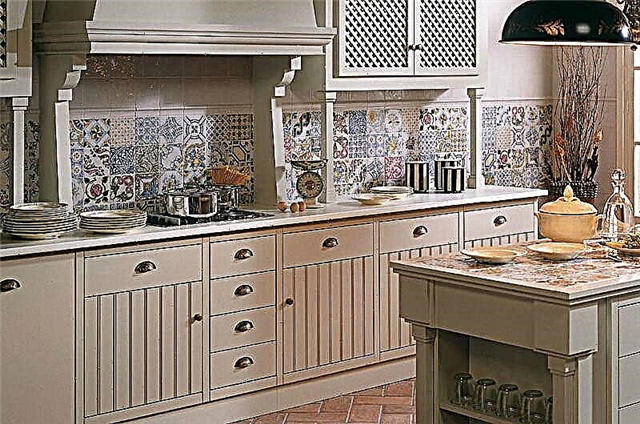
Looks great mosaic kitchen apron

Mosaic can decorate countertops for kitchen furniture

Custom solution - decorating the kitchen sink mosaic
In the kitchen, two-color mosaic tiles are often found. Widely known models using white in combination with green, blue or purple. A little more expensive, but more original will be the use of tiles to create a picture in the kitchen.
What style is suitable
Mosaic is a universal decor and is suitable for many styles. It all depends on the color, texture and selected pattern. An important role is played by the location of the mosaic element. For some currents, decoration of walls is characteristic only, for others this is unacceptable. Therefore, it is worth focusing on the laws of the chosen style. We will divide all the proposed areas into two broad groups: historical and modern.
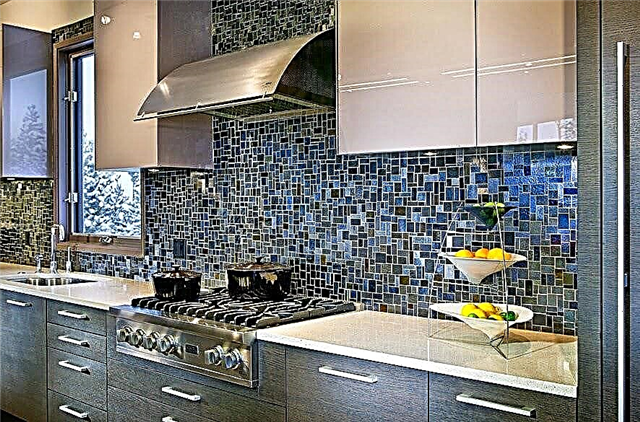
Mosaic can be present in the interiors of rooms of various styles, from country to hi-tech
Antiquities
Since the mosaic was invented and gained popularity in antiquity, it is often used to recreate historical motifs. It is widely used in the direction of Baroque and Rococo. In these times, this art was used mainly for flooring.

Roman mosaic floor
In Gothic times, this species was widespread for the decoration of various surfaces. Along with stained glass, it was used within the windows, on the walls, as well as on the floors. This style is rather gloomy, characterized by sharp corners and straight lines, so choose a dark matte tile to recreate it.

Gothic mosaic panel
The Victorian era is completely different, which is reflected in the design accordingly. The style, which received the same name, is characterized by pomp and luxury in everything from decoration to trifles. This area is characterized by large images and large interior items, therefore large elements and corresponding patterns should also prevail in the drawing.

A combination of English Victorian sophistication with colonial Indian motifs
Mosaic was also widely known during the Renaissance. Here it was used everywhere. The Renaissance is considered one of the most beautiful, so colorful and positive motifs prevail in the ornaments and drawings. The direction is not without brilliance and luxury, which is also displayed in the cladding.
Modern destinations
Despite the fact that the mosaic mainly emphasizes the old directions, it is widely used in modern design. And with the advent of new materials and types, it has become quite popular at the present time.

Marble mosaic in a modern bathroom
Perfect for a Mediterranean style flow. It has pronounced Greek motifs, so glossy and light tiles will only emphasize the merits of the direction. In this case, mosaic tiles are used primarily for flooring. Artificial balconies and the corresponding arrangement of a bay window are widespread here. For these areas, this type of finish fits perfectly. Speaking of colors: in the Mediterranean style they mainly use white, the whole spectrum of blue, light brown, green.

Light, natural and warm Mediterranean style atmosphere
Provence is another style common in modern design. It is also called French country, so it is distinguished by tenderness and warmth. The hallmark of this trend is beige color and rustic motifs in the design. In this case, the mosaic look is used mainly in the design of the kitchen. It is desirable to select models from natural materials, light pastel colors and fine texture.

Rustic natural ornament
The classic stands apart. She absorbed the trends of antiquity, and at the same time underwent some changes in accordance with the present era. It is also acceptable for her to use the described art. But in this case, it is necessary to focus on rigor and conciseness. The classic is distinguished by soft lines, but does not suffer frills. Match simple patterns and soft colors to show classic direction.
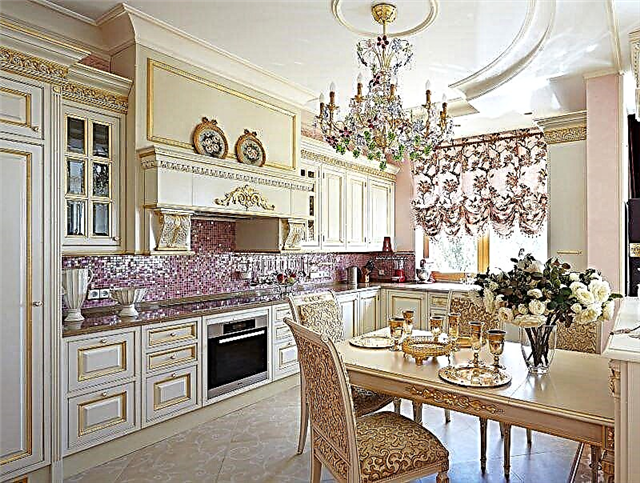
Pink apron in the kitchen in a classic style
Summarize to determine the necessary style.
| Style | Color preferences | Picture |
| Baroque | Blue, pink, white, golden blotches required | Complex shapes, elaborate figures, ornate lines |
| Gothic | Brown, gray, black, white | Simple motifs with linear images. |
| Victorian | Brown spectrum, shades of green and yellow | Recreating portraits of famous people, coats of arms and symbols of the Victorian era |
| Renaissance | Pastel shades | Images of angels, ornate figures |
| Mediterranean | The whole range of blue, white, green, purple | Marine focus, plain light base |
| Provence | Beige, Ivory, Olive, Yellow | Village motifs, imitation of natural materials |
| Classic | White, beige, black, dairy | Simple images or plain color |
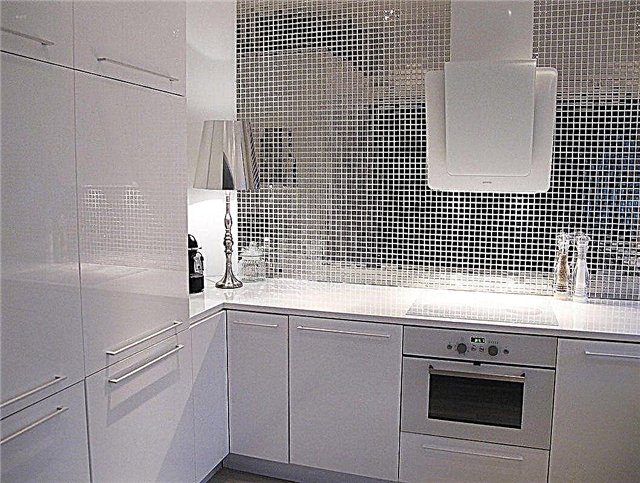
White gloss modern kitchen in mirror reflection of mosaic wall
Thus, if you decide to use mosaic in the interior of your apartment, choose a style to start with, and then, acting in accordance with its laws, determine the structure and type of tile.
In addition to full or partial decoration of walls or floors, you can use mosaic tiles to create interesting decorations that will become part of the design. Mosaic decoration of vases and caskets is still popular, and this technique is also used in creating original frames for photographs.

In the modern interior, original motifs reminiscent of African and Arab culture are increasingly being used.

Mosaic provides a huge choice for the imagination of any designer or a simple person who wants to decorate his home
For a long time of existence, this type of finish is well established. If you are thinking about mosaic in the interior of the kitchen, do not hesitate for a long time. Feel free to make a positive decision.

